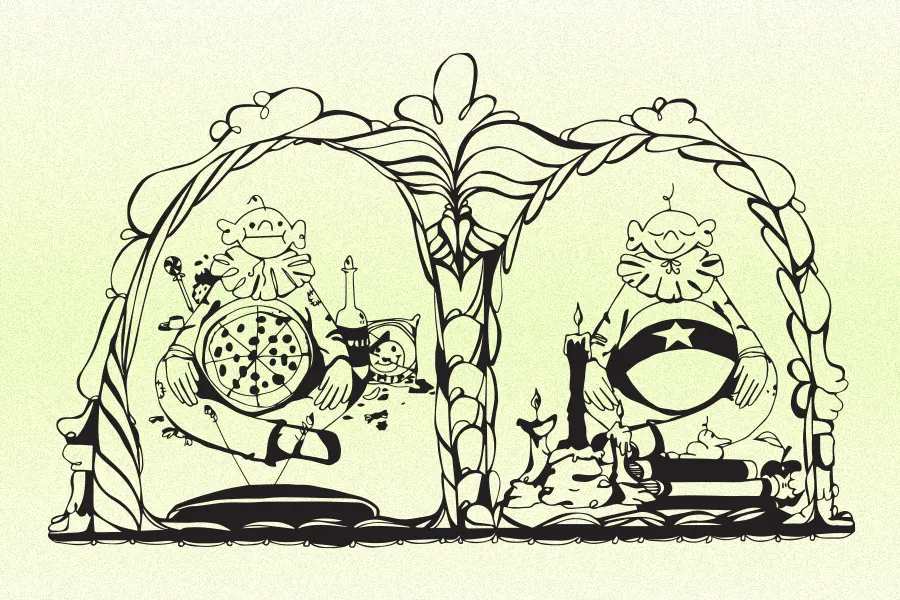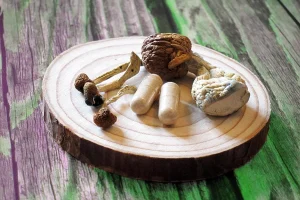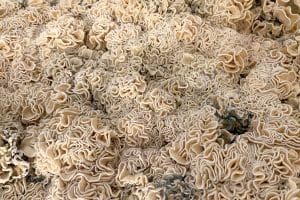We live in a culture of intense and constant influence. Your morning coffee influences your heart rate and speed of productivity. Your inbox influences your mood. Your Instagram influences your self-esteem and sense of belonging. Ultimately, everything you take in comprises a complex diet that, for better or for worse, determines your physical, mental, spiritual, and emotional reality.
When drinking ayahuasca, the intention is to strip all of this external stimulus down to just a single communication: that from the ayahuasca itself.
“It’s this idea that it’s you, yourself, and the plant,” says Jason Grechanik, who’s spent a decade living, studying, and working in the Amazon, where he runs plant medicine dietas and facilitates ayahuasca workshops at a retreat center called Temple of the Way of Light. “There’s nothing else to be confused by, so whatever information is coming to you, you can be pretty certain it’s the plant.”
Thus is the goal of the ayahuasca dieta, typically a core element of the ayahuasca experience that involves eliminating myriad foods, beverages, and activities from one’s diet during a prescribed period before, during, and after an ayahuasca ceremony. While crossover exists between the two practices, there is a difference between the ayahuasca dieta (the cleanse a person does in order to drink ayahuasca and what we’re talking about here) and a dieta with a specific plant or plants (when a person goes into isolation and consumes plants, often as a form of training before facilitating ceremonies). The goal of the ayahuasca dieta is to help purify, prepare, and protect the body and mind before, during, and after an ayahuasca retreat, and to foster direct and unfettered communication
with the Banisteriopsis caapi (or ayahuasca) vine and Psychotria viridis (or chacruna) leaf brew—and the realms that ayahuasca opens.
“A lot of Indigenous healers and people who work with plants have this view that the plants are very powerful, but that’s not the whole process, and a lot of healers would say that without the dieta, the plants don’t work,” says Grechanik. “It’s not that they have no effect… But to really experience the deeper healing effects of the plants, you have to enter a dieta.” While ayahuasca dietas vary between traditions and healers in terms of prohibited items and
duration, almost all ayahuasca traditions include some form of a dieta, and many prohibit the same key items and activities. “A lot of these different traditions came to the same conclusions in terms of certain things being or not being conducive to the dieta,” Grechanik says, “which I think gives a lot of validity.” These restrictions are most commonly abided by in the time leading up to an ayahuasca ceremony or retreat, and the period following it, which again can vary in length by tradition. Grechanik notes that this follow-up period is especially important for abiding by the dieta, as this is when “you have this medicine in you, there’s been a change, you’ve been cleaned physically or have these insights into yourself, and the way these really stick is creating an environment where the energy can continue to grow.” Foods during the retreat itself, which can range from a single ceremony to multiple ceremonies over the course of weeks or months, are limited to a very mild diet of mostly vegetables, a grain like rice or quinoa, and often a boiled egg for protein. The strictness of such dietas varies by tradition, and unless one is at an ayahuasca retreat center in the period before and after a ceremony, most dietas are self-monitored.
In his studies, Grechanik has most often observed the dieta to prohibit pork, cold and spicy foods, sex, and alcohol. Here, he discusses the reasoning behind abstaining from each during an ayahuasca dieta.
PORK

While the consumption of red meat is rarely advised during a dieta, pork specifically is the most commonly restricted item. Grechanik concedes that “everyone you ask will give you a different answer” regarding pork’s exclusion from the ayahuasca-approved diet, with such reasoning including notions of cleanliness and religious considerations as outlined in kosher and Islamic traditions. But the best “and maybe most egalitarian” way to consider the elimination of pork—including ham, bacon, sausage, and other items made with pig
products—is simply that pork is contraindicated to plant work. “They would say that eating pork cuts the work,” says Grechanik.
How to Grow Shrooms Bundle
Take Both of Our Courses and Save $90!
The thinking here is that if you’re working to receive healing from a plant—be it ayahuasca or something else—you want that plant to keep working for as long as it needs to. Pork would “cut” this work by stopping the plant from continuing its function. “You want to give it two weeks, or a month, or whatever amount of time to really allow that plant to fortify itself, so your body becomes strong enough and your mind becomes solidified,” Grechanik says of reintroducing pork after a dieta. “You have to allow the protection to seal. You have to let the paint set.”
ICE & SPICE

This category includes items like ice cream, ice-cold beverages, and anything either particularly cold or acutely spicy, like peppers or certain seasonings. The reasoning here is that such items might shock the system (and thereby cut the work) during a period when the body is particularly tender. “Your system is very open and very sensitive,” Grechanik says of the time period around an ayahuasca ceremony, “and you don’t want to take [in] anything that’s going to aggravate that.”
SEX

Yes, this includes both sex with a partner and with yourself. The reasoning here is the potency of sexual energy, which has the power to literally create life. The use of such a potent force is not appropriate during the time before, during, and after drinking ayahuasca, as the dieta causes a weakening of the body that’s useful to plant work.
“If you’ve ever been really sick, like a bad flu, and your body is super weak and you can barely move, often we’re almost going into an altered state of consciousness,” says Grechanik. “We’re very open to things. We’re very perceptive. That’s because the body has become weak.” With this same type of opening through weakening happening during dieta, incorporating the force of sexual energy can cause the body to weaken to a point of being
unhealthy.
Sex is also on the list because, when done with a partner, it involves entering into union on physical, energetic, emotional, and spiritual levels. With the intention of ayahuasca being to go inward, joining with someone through
sex can cause energies to become mixed in a way that leads to confusion. “It would be called crossing the diet, because now there’s an energy there which isn’t ours,” says Grechanik.
Such energetic crossing might involve taking on something from a partner or inadvertently releasing something into a partner, as the purging inherent to an ayahuasca experience can last well after the actual ceremony is over.
“It’s almost a universal phenomenon with plant work, that we’re releasing things. So if we really care about our partner or whoever we’re having sex with,” says Grechanik, “we don’t want to inadvertently be releasing stuff in the dieta or post-dieta that is potentially going into them.”
ALCOHOL

Cutting out alcohol has to do with the sensitivity of the body during dieta, when our systems are very open and often weak. Like spicy and cold items, alcohol is quite strong, so it can shock the system. In Spanish they’d call it chocar or ‘hit’—“like a hit from something very strong,” says Grechanik.
With many alcohols distilled from plants, a lot of alcohol is also, in and of itself, a plant medicine. (Consider that in English, liquor is often referred to as a “spirit,” since it’s the extracted essence, or spirit, of a plant.) “We don’t want to take in outside information in the same way we don’t want to work with other plants during the dieta,” says Grechanik. “We want to work with one plant, because otherwise how do I know what’s what? What am I getting from where?” This consideration thus extends to cannabis, cocaine, heroin, and other plant-derived substances, particularly these strong ones. “You wouldn’t even drink something like chamomile or green tea,” adds Grechanik, “because those are also plants.”
OTHER CONSIDERATIONS

Many dietas recommend cutting out fried foods, sugar, caffeine, and salt in the time before, during, and after ceremony, as these foods are considered less pure and therefore less conducive to the creation of a clear vessel in which the ayahuasca can work. (The prohibition of salt specifically has to do with its grounding properties, which can lead to one being less open during ceremony.) Substances including MDMA, mushrooms, and LSD are also typically forbidden by most dietas. It’s also crucial to be forthright with your facilitator about any SSRIs like antidepressants or other pharmaceutical medications you’re on, whether over the counter or prescribed, as they may contraindicate with the ayahuasca. Grechanik says Indigenous traditions advise that it’s best to be off of all pharmaceutical drugs and to check with the person you’re working with if there are any doubts about anything you’re taking.
You may also consider your consumption of books, movies, and television, and particularly any media that’s ultra-violent. Grechanik says it’s “probably not a wise idea” to go on social media and pummel your brain with everything that’s happened in the world while you’ve been logged off, as this experience can cause overwhelm. “Ideally we want to ease ourselves back into [media],” he says, “and not because it’s bad, but it’s a lot of information coming at
us when we haven’t been taking that in.”
*This article was originally published in DoubleBlind Issue 7.

DoubleBlind is a trusted resource for news, evidence-based education, and reporting on psychedelics. We work with leading medical professionals, scientific researchers, journalists, mycologists, indigenous stewards, and cultural pioneers. Read about our editorial policy and fact-checking process here.

DoubleBlind Magazine does not encourage or condone any illegal activities, including but not limited to the use of illegal substances. We do not provide mental health, clinical, or medical services. We are not a substitute for medical, psychological, or psychiatric diagnosis, treatment, or advice. If you are in a crisis or if you or any other person may be in danger or experiencing a mental health emergency, immediately call 911 or your local emergency resources. If you are considering suicide, please call 988 to connect with the National Suicide Prevention Lifeline.



